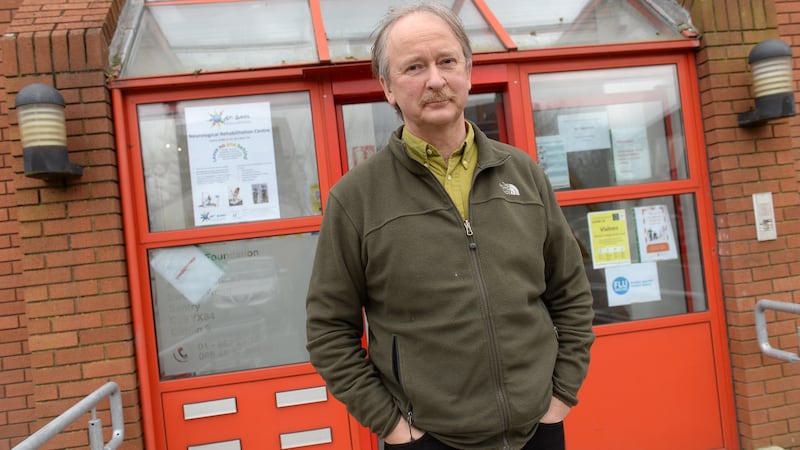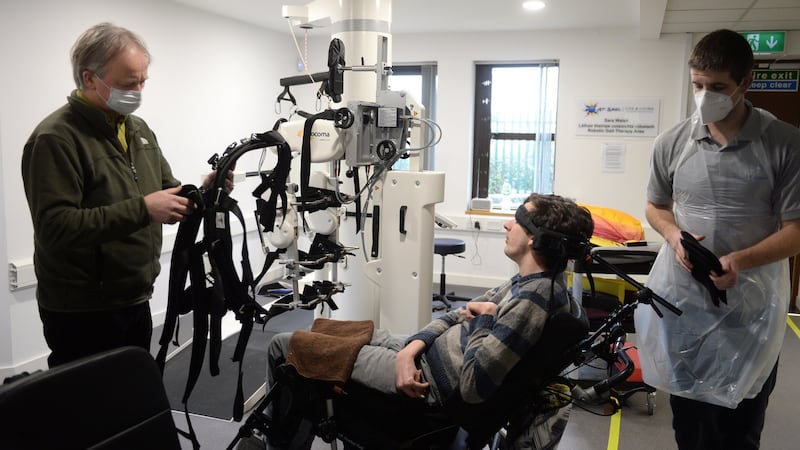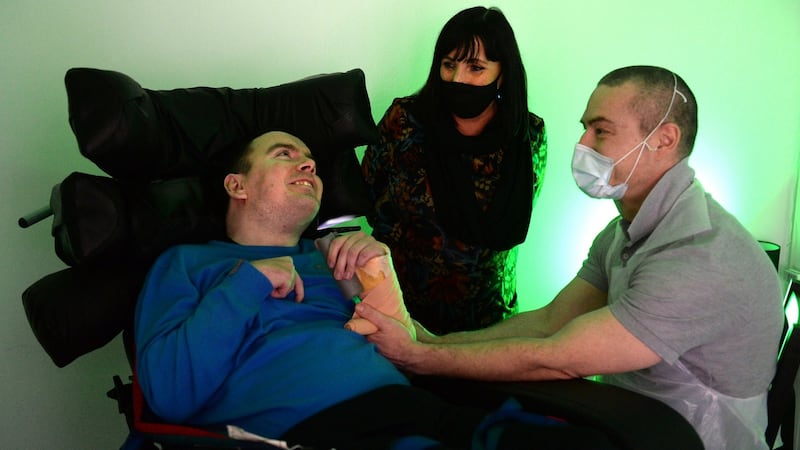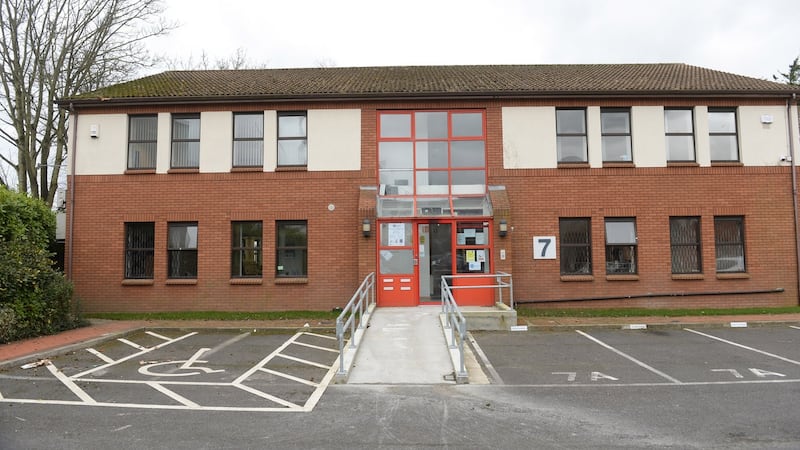As Pádraig Schaler’s arms and legs start to move in very slow motion above the treadmill, it appears for a moment as if he is suspended in zero gravity. But soon his black Nike runners are striking the rubberised track and his stride begins to quicken.
With eyes closed in an expression of contentment under a mop of brown hair, his 6ft 7in frame is upright and moving by means of a robotic exoskeleton suit supporting him from the top of his head to the base of his feet. His mode of transport for the other 23 hours of the day, a wheelchair, stands empty to one side in the An Saol neuro-rehabilitation centre in north Dublin.
It will be eight years ago this summer since Pádraig headed off to the US on a J1 visa, having just completed his undergraduate studies in Irish and history at Trinity College Dublin. Cycling to work in Cape Cod on June 27th, 2013, he suffered a severe brain injury when his bike was hit by an overtaking truck.
You panic, you fight and then you fundraise. This should not be about charity
Ever since, his parents, Reinhard Schaler and Pat O'Brien, have fought tirelessly against medical and societal writing off of their son, and other survivors of severe brain injury, as hopeless cases. At the outset, in the US hospital, doctors talked to them on several occasions about organ donation and "that scared us", says Reinhard.
The couple arranged for their son to be flown home to Beaumont Hospital in Dublin two and a half weeks after the accident. They were told he would have to wait a year to get into the National Rehabilitation Hospital (NRH) in Dun Laoghaire, Co Dublin, for three months of assessment and treatment. The couple took him to Germany instead for treatment and rehabilitation and ended up spending more than two years there.

“This made all the difference because there we learned how a different system works,” says Reinhard. It is knowledge they have been using to try to improve services in Ireland for Pádraig and others with a severe acquired brain injury (sABI).
While the couple must vocalise on their son’s behalf as he has no speech, Pádraig makes his views known through using finger movements, for instance, to answer yes and no to questions and can rate anything, from his bodily comfort to his view of a TV programme, by tapping a scale of 1 to 10.
“A doctor once said to me ‘I hear gallop and I think horse’. But sometimes it is not a horse,” says Reinhard. “You see Pádraig and you think, he doesn’t move, he doesn’t talk. A normal person’s perception is that there isn’t much going on, the lights are out. That is absolutely not the case. Pat discovered he can [still] read and write. Pádraig laughs, not at my jokes but his sisters’ jokes, he hasn’t even changed.
“He has always gone for the most expensive food,” Reinhard says with a smile. “If we go anywhere, he knows what he wants. He enjoys the company of his friends. He votes; same party and same candidates as before.
“He can do Who Wants to be a Millionaire questions; he can sum up numbers and give you the result. He is well able to communicate, if we give him the means.”
Pádraig was the inspiration behind their setting up of the An Saol Foundation in 2014 to provide adequate and ongoing support for people with a sABI. It is now running the first community day centre that can offer them ongoing neuro-rehabilitation.
Based in Santry, the doors opened in January 2020 only to have to close again two months later in the first lockdown. But since reopening last July, it has been able to continue to operate throughout Level 5 restrictions, albeit at a reduced level.

It is a three-year pilot project, with €1.5 million funding from the Health Service Executive (HSE), aimed at showing how An Saol can deliver neuro-rehabilitation in a new way, based on research and well-established practices in countries such as Germany.
The idea is to offer an inclusive, neuro-rehab programme five days a week, covering physiotherapy, occupational therapy, speech and language therapy, as well as cognitive, music and trauma therapies, along with social activities and family programmes. In a technology room, clients can be trained in communication aides, such as eye tracing.
Currently, some clients funded by the HSE attend in the morning while private clients with funds, say from settled insurances cases, come for therapies in the afternoon.
It has long been recognised that the pathway to rehabilitation in this country more or less runs out for people with an sABI after they leave the NRH – if they are lucky enough to get a bed there in the first place.
In theory, follow-up therapy is provided through community clinics – that is, if a brain injury survivor can go home, because too often a nursing home is the only option for severe cases. However, community clinics are not set up to provide lifelong support, which is what most people need, says Reinhard. “What we are doing here, not by design but by accident, fits right into the HSE strategy of trying to get people out of congregated settings.”
But, to survive in the community, they need back-up.
Instead of people having to find their own therapists, “wouldn’t it be better if there was a place where families could be centrally involved, their voice would be heard and having access to the kind of services that they need?” he asks.
Brain injury
Catherine Cahill comes to An Saol with her son David (34), who suffered a brain injury at the age of 21 through several heart attacks while on holiday in Crete. He was in a nursing home for six years, before she managed to managed to get him back into their Ballymun home. “It’s so good for him,” she says of the stimulating physical therapy he receives at An Saol.

Reinhard sees it very clearly as a human rights issue. “It is about the right of people to live their life in the best possible way and that is the core of everything,” he says.
He recalls how a neurologist said she understood the personal tragedy involved in an sABI but that they had to understand that the limited resources of a health system had to be invested in patients who had a reasonable chance of recovery.
He took that to mean you spend on people who can be healed and everything else is a waste. But it’s not, he argues. Look, for instance, at how the hospice movement has evolved to help people to die with dignity. “If as a society we help people to die in dignity, why we do we have problems helping people live with dignity?” In looking at how to make that happen, he says: “I am convinced it is not a financial question, it is an organisational question.”
What the An Saol centre offers families is not more expensive, he says, “it is more specialised and more targeted, and it is based on the latest research and knowledge in relation to neuro rehabilitation”.
Reinhard has struggled with knowing that politicians and medics in this country have recognised for many years how survivors of severe brain injury are so often consigned to an existence of “nutrition, hydration, medication”, yet have done little about it. The Neuro-rehabilitation Strategy published in 2011 by the Department of Health and the HSE acknowledged the many gaps in services, but another eight years passed before a three-year framework, From Theory to Action, was published in 2019.
That framework looked at what is specifically needed after acute hospital care, says Mags Rogers, executive director of the Neurological Alliance of Ireland (NAI). This ranges from treatment in the NRH, or equivalent, to the likes of An Saol, residential centres, respite; "basically, it's the wraparound for people living longterm with brain injuries or other neurological conditions," she says.
The NAI estimates that just 30 rehabilitation beds have been added since 2011. “We should have a minimum of 288 beds based on international estimates for our population size. We have about half that,” says Rogers.
While there is a rollout of a national trauma strategy for acute hospital care of the estimated 1,600 patients a year in Ireland who suffer multiple injuries, most of whom are unlikely to be unscathed neurologically, there is no side-by-side neuro rehabilitation developments, she says. It has been estimated that less than 10 per cent of people with major trauma are getting access to specialist rehabilitation.
“Our trauma care is very, very good and getting better,” says Rogers. “We are saving people who we never would have saved.” But we are falling down on rehabilitation.
Referrals to the NRH are increasing, so patients are receiving shorter periods of rehab because they want to get the next person in, she says. The building of the new hospital there did not increase the number of beds.
“The further you are from Dublin, the less likely you are to be seen by a neuro rehabilitation consultant and less likely to be referred to the NRH.”
There was a plan to put a multi-disciplinary neurological rehabilitation team into each of the nine Community Health Organisation (CHO) areas by the end of this year. “Since late last year, they have funded partial teams in two CHOs, six and seven, in the eastern half the country,” says Rogers.
Meanwhile, families like Pádraig’s who knew absolutely nothing about brain injuries until they were directly affected, are trying to improve the system for their loved ones. “If we don’t do it, nobody else will,” says Reinhard. He has seen other families go through the same cycle when tragedy strikes: “You panic, you fight and then you fundraise. This should not be about charity.”
The An Saol day-care centre has not been set up by professionals or by a company or by the HSE, but by families, he points out. While he and Pat took the initiative, others have collaborated and been consulted, as have therapists, in planning the best way forward. “There has been a lot of learning. It is really implementing what the HSE has been saying about patient centred care.”
Support
He pays tribute to Finian McGrath, a former minister of state for disability issues, and local TD Róisín Shortall for their support in helping to make it happen, and Simon Harris who, as minister for health, secured the €1.5 million funding from the HSE – €500,000 for equipment and €330,000 a year to run it for three years.
The section of the centre where Pádraig walks for 45 minutes a day, as rehabilitative exercise specialist Barry Moore adjusts the speed and weight bearing, is named the "Sara Walsh robotic gait therapy area". She was two beds away from Pádraig in Beaumont Hospital and both their families got to know each other well.
Sara, an electrical engineer, was 28 and married just four months when she suffered a brain injury in October 2011, after a biopsy on what turned out to be a benign brain tumour. She spent two years and three months in Beaumont before getting a bed in the NRH.
From there she was transferred to Donnybrook hospital, but her family managed to get her to what her mother Mary describes as “rehabilitation boot camp” in Germany where therapists got her back up on her feet and dispensed with peg feeding.

During her time there, Mary recalls how Sara’s sister came over to visit and asked a therapist if she could try something on a keyboard with her. Sara then joined her sister in playing a duet they knew as children and she was “note perfect”, says their mother, breaking down at the memory.
But soon after their return to Ireland, it was discovered that Sara’s brain tumour, which was inoperable but had been treated with radiation, had grown back and she was transferred to Blanchardstown hospice, where she died on June 17th, 2015. After their daughter’s death, the family passed on funds that had been raised by well-wishers for her ongoing care to Pádraig’s parents.
It was this that got the An Saol Foundation off the ground. "It would have been so easy for them to take that money and pour it into Pádraig," says Mary, "but they have worked tirelessly for other people too."
Sara “loved” the robotic gait therapy she received in Germany, her mother adds. So there is nowhere more appropriate for her name to be enshrined, than where brain injury survivors can enjoy the benefits, as we all do, of being upright and moving.












